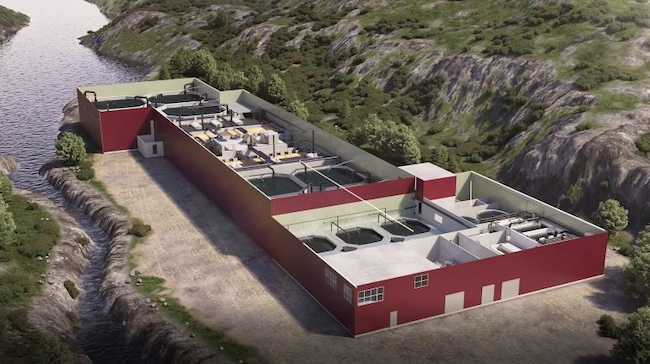
News & Views
New RAS facility in Norway to produce 3.2 million post-smolts annually
AquaOptima and Vikan Settefisk have partnered to build a smolt and post-smolt RAS facility in Frøya, Norway. The foundations are nearly complete, and the facility is scheduled for completion in late 2019, according to a statement from AquaOptima.
November 9, 2018 By Hatchery International staff
 rendering of what would be Vikan Settefisk's new RAS facility in Froya
rendering of what would be Vikan Settefisk's new RAS facility in Froya “We can see that post-smolt facilities are going to be a big deal in the industry in the years to come, and we want to be at the forefront of this development,” said Børge Søraas, CEO of AquaOptima. “Compact RAS facilities constitute a competitive advantage for fish farmers.”
The RAS facility at Tverrvågen on Frøya will be a smolt and post-smolt facility, with a mix of salmon and trout production in seawater, where each species is kept in different sections.
Production tanks at the facility will have a total volume of 7,000 m3, and an annual production capacity of 3.2 million post-smolts. The RAS facility is constructed in collaboration with building contractor Petter Bakøy AS. Overhalla betongbygg will supply the tanks, AquaOptima said.
The production tanks will serve as both fish tanks and external walls. Because the wall continues where the tank edge ends, the facility will be both area-efficient and economically favourable for the farmer, the company explained.
“The facility is both compact and efficient; most functions are automated. A high degree of automation means the facility can operate with a minimum of staff. Post-smolt are in high demand in the industry right now. We have considerable expertise in this area, and we want to focus our energy even more in this direction in the time to come,” Søraas explains.
Vikan Settefisk, a Norwegian smolt producer, said it is investing over NOK 140 million (US$16.6 million) in this new RAS facility, pointing out it is a necessary upgrade to meet future demand.
“We are working very closely with AquaOptima. In the initial phase, they will provide us with training, because a lot of this is new to us,” said Frode Reppe, founder of Vikan Settefisk, in a statement.
“For us, this is a do-or-die situation. If we want to be a contender on the juvenile fish side of the industry, we need bigger volumes and bigger fish. This offers greater flexibility in terms of placing and makes us able to deliver on demand.”
The two companies worked closely to map out the criteria of the facility, customized according to Vikan Settefisk’s requirements.
“The Vikan facility is designed based on the client’s contributions and wishes, and it is a testament to what we can do. This facility is most definitely not off-the-shelf, and we have made good use of our technology, keeping a strong focus on optimal water quality.”
The RAS facility also has technology in place to prevent the accumulation of organic material, preventing incidents involving hydrogen sulfide (H2S), AquaOptima said.
The design makes it easy to identify H2S risks, where particles in waste water can sediment and accumulate in pumps or sumps. If this sediment is not removed and begins to decompose it could produce H2S, which is extremely toxic to the fish.
“This problem is especially common in salt-water systems, and we have taken steps to reduce the risk of sediment accumulation. Even so, it is important that the operator keeps an eye out for any accumulation,” Søraas explained.
Print this page
Advertisement
- Joint venture forms salmon research hub in Chile
- Washington hatchery renovations to expand salmon production





